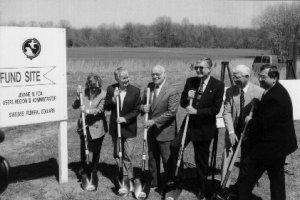|
III. Progress at Contaminated Sites (cont.)
Superfund site remedial actionsSites administered under the Federal Comprehensive Environmental Response, Compensation and Liability Act of 1980 (CERCLA) and the Superfund Amendments and Reauthorization Act of 1986 (SARA) are commonly known as Superfund sites. Investigation and cleanup work at these sites is funded by a responsible party(ies) or by a combination of federal and state funding when the responsible party cannot be identified or is unwilling or unable to conduct the cleanup. When public funds are used, the proportion of federal to state funding varies depending on the type of site, with the majority of funds usually supplied by the federal government. The Department works with the U.S. Environmental Protection Agency (USEPA) to implement remedial actions at New Jersey's Superfund sites.
During the past decade, the Department and the USEPA have made significant progress in cleaning up Superfund sites located in New Jersey. More than 60 percent of environmental concerns at these sites have been addressed. As of June 30, 1998, a total of 121 sites in New Jersey had been placed on the NPL for Superfund cleanup since the inception of the Superfund Program. Fourteen of the 121 sites have been removed or are proposed for removal from the Superfund list, leaving 107 active NPL sites. (Four additional sites were proposed for inclusion on the NPL in July and September 1998 and two of these became final in January1999. Two other sites were deleted and one site was partially deleted from the NPL in December 1998. These actions bring the total number of active Superfund sites in New Jersey to 109 as of February 1999.) For the purposes of evaluating the progress of cleanup activities in the Superfund Program, it is important to understand how sites move through the remedial process. A site is usually divided into subsites or operable units, allowing for variation in the speed or extent to which environmental concerns at a site are addressed. This approach allows subsites with immediate environmental concerns to be dealt with first, such as those requiring removal of surface waste or contaminated waste materials to prevent the threat of direct contact or off-site migration. The remaining subsites that move through the remedial process usually involve more complex environmental concerns requiring studies and cleanup actions such as treatment of contaminated soil or ground water. The original 121 Superfund sites have been divided into 408 subsites as of June 30, 1998. Of this number, 252 subsites, or 62 percent of the total, no longer pose a threat to public health or the environment. They either have been completely remediated or are being addressed through long-term operation, maintenance and monitoring. Of the remaining 156 subsites, some type of remedial work is underway at 151. Figure 5, entitled New Jersey's Superfund Subsite Status, compares remedial activities at New Jersey's Superfund subsites as of the end of SFY97 and the end of SFY98. Ten additional subsites were given an NFA designation and seven other subsites moved to a maintenance-only status after all investigation and cleanup activities were completed. Most subsites routinely require a series of remedial projects, as described below. The project types are Remedial Investigation and Feasibility Study (RI/FS or Study), Remedial Design (RD), Remedial Action (RA) and Operation and Maintenance (O&M). The status of the 408 Superfund subsites as of June 30, 1998 shows 67 RI/FS subsites; 43 RD subsites; 41 RA subsites; 73 O&M subsites; 179 NFA subsites; and, five subsites where no work has been initiated.
Project definitionsA Remedial Investigation and Feasibility Study (RI/FS)is an integral part of the remedial process. It is essential to determine the extent and nature of contamination and to identify acceptable alternatives for cleanup. Substantial effort is expended in characterizing the environmental problems generated by the site. The Remedial Design (RD) develops plans and specifications to address the environmental concern(s) and achieve the most effective remedial action. Remedial Action (RA) implements the design and includes removal of contaminated soil, capping, treatment of ground water or drinking water, fencing and other actions. This type of project entails removal or stabilization of contaminated material. It is the most visible indicator of cleanup progress. Operation & Maintenance (O&M) occurs once construction work required is completed or if monitoring only is necessary. Operation and maintenance activities are often necessary to achieve cleanup standards for a subsite and/or to ensure a successful remediation of a site.
SFY98 NPL site activitiesDuring SFY98, 32 new remedial projects were initiated at Superfund sites. Twenty-one of the 32 projects are being funded by responsible parties while the other 11 were started with public monies. During this same time period, 25 remedial projects were completed. Fourteen were funded by responsible parties while 11 were paid for with public funds. The tables below also provide information for State Fiscal Year 1996 (SFY96) and SFY97.
|
|||||||||||||||||||||||||||||||||||||||||||||||||||||||||||
| To report an environmental
incident impacting NJ, call the Toll-Free 24-Hour Hotline |
||
Contact DEP | Privacy Notice | Legal Statement & Disclaimers | Accessibility Statement |
||
Site Remediation Program: SRP
Home | About SRP |
Search | Help Copyright © State of New Jersey, 1996- |


